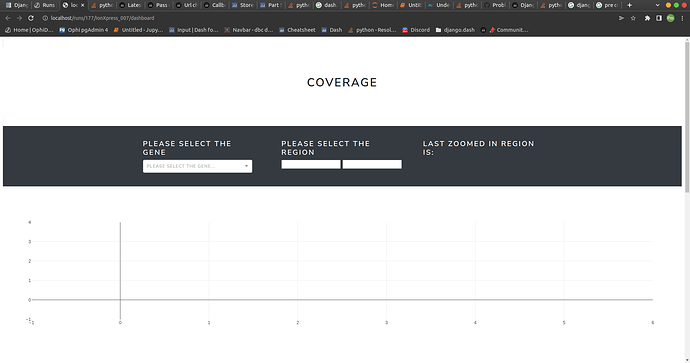So i’ve had an issue where i couldn’t access my initial arguments but after i got some help in this forum i was able to access it.
Now i’m having a problem where sometimes the context doesnt load in my dash app but other times it will, it feels like it’s random.
I will provide all my code below and some screenshots with an example of my dash app
VIEWS.PY
def dashboa(requests, **kwargs):
id_ = kwargs.get('pk')
barcode_ = kwargs.get('barcode')
rundata = get_object_or_404(models.RunData, run_id=id_)
runsample = get_object_or_404(models.RunSampleData, rundata=rundata, barcode=barcode_)
file_path = get_file(runsample)
df = pd.read_csv (file_path)
context={}
context = {"dash_context":
{"bed_file_path":
{"children": file_path}}}
print('ESTA PARTE É DO DJANGO', context)
return render(requests,'runs/dash.html', context=context)
DASH.APP
import dash_bootstrap_components as dbc
import dash
from dash.dependencies import Input, Output
import dash_core_components as dcc
import dash_html_components as html
import plotly.graph_objects as go
import plotly.express as px
import pandas as pd
import json
from django_plotly_dash import DjangoDash
from . import views
app = DjangoDash(name='dash_app', external_stylesheets=[dbc.themes.LUX])
# class DbResult:
# def __init__(self, data=None):
# self.data = pd.read_csv('HD40755__IonXpress_009__Auto_user_GSS5-0407-124-CHIP1_03022022_393_333__basedepth.csv', header=None)
# def store(self, data):
# self.data = data
# db_result = DbResult()
# db_result.data
df = pd.read_csv('HD40755__IonXpress_009__Auto_user_GSS5-0407-124-CHIP1_03022022_393_333__basedepth.csv', header=None)
df.columns = ["Chromossome", "Region", "Coverage"]
df=df.sort_values(by=['Region'])
dfR=pd.read_csv('ampliconsRightChr.csv')
dfR.columns = ["Chromossome", "Initial Position", "Final Position", 'coverage_mean','coverage_min','coverage_max']
dfgene=pd.read_csv('GenePosition.csv')
dfgene = dfgene.sort_values('Initial_Position', ascending=True).drop_duplicates('Gene')
dfgene['Chromossome'] = 'chr' + dfgene['Chromossome'].astype(str)
# def handle_data():
# df = pd.read_csv('HD40755__IonXpress_009__Auto_user_GSS5-0407-124-CHIP1_03022022_393_333__basedepth.csv', header=None)
# df.columns = ["Chromossome", "Region", "Coverage"]
# df=df.sort_values(by=['Region'])
# dfR=pd.read_csv('ampliconsRightChr.csv')
# dfR.columns = ["Chromossome", "Initial Position", "Final Position", 'coverage_mean','coverage_min','coverage_max']
# dfgene=pd.read_csv('GenePosition.csv')
# dfgene = dfgene.sort_values('Initial_Position', ascending=True).drop_duplicates('Gene')
# dfgene['Chromossome'] = 'chr' + dfgene['Chromossome'].astype(str)
# lastdf = margeDF(minus1,plus1, dfR, df)
# lastdf = lastdf.sort_values('Coverage', ascending=False).drop_duplicates('Region').sort_index()
# lastdf = lastdf.sort_values(by=['Region'])
# return (df,dfR,dfgene,lastdf)
def plus1(dataframe):
data = []
for index, row in dataframe.iterrows():
data.append([row['Chromossome'] ,row['Initial Position'] + 1, row['Final Position'] + 1])
df = pd.DataFrame(data)
df.columns = ["Chromossome", "Initial Position", "Final Position"]
return(df)
def minus1(dataframe):
data = []
for index, row in dataframe.iterrows():
data.append([row['Chromossome'] ,row['Initial Position'] - 1, row['Final Position'] - 1])
df = pd.DataFrame(data)
df.columns = ["Chromossome", "Initial Position", "Final Position"]
return(df)
def margeDF (minus1,plus1, df1, dfbed):
df2 = plus1(df1)
df3 = minus1(df1)
df3 = df3.melt(id_vars=["Chromossome"],
value_name="Region")
df3 = df3[['Chromossome','Region']]
df3['Chromossome'] = 'chr' + df3['Chromossome'].astype(str)
df2 = df2.melt(id_vars=["Chromossome"],
value_name="Region")
df2 = df2[['Chromossome','Region']]
df2['Chromossome'] = 'chr' + df2['Chromossome'].astype(str)
frames = [df2, df3]
result = pd.concat(frames)
frames2 = [result, dfbed]
result2 = pd.concat(frames2)
result2 = result2.reset_index(drop=True).fillna(0).sort_values(by=['Region'])
return result2
lastdf = margeDF(minus1,plus1, dfR, df)
lastdf = lastdf.sort_values('Coverage', ascending=False).drop_duplicates('Region').sort_index()
lastdf = lastdf.sort_values(by=['Region'])
app.layout = html.Div(id = 'parent', children = [
html.Span(html.H1(id = 'H1', children = 'coverage', style = {'textAlign':'center','marginTop':80,'marginBottom':80}), className="border rounded"),
html.Div(id='bed_file_path'),
dcc.Store(id='intermediate-value', storage_type='local'),
dbc.NavbarSimple(children=[
html.Div(style={'display': 'inline-block', 'vertical-align': 'top', 'margin-right': '5vw'},children=[
html.H4("Please select the Gene", style={'color':"white"}),
dcc.Dropdown(
options=[{'label': c, 'value': c} for c in sorted(dfgene['Gene'].unique())],
optionHeight=35,
searchable=True,
search_value='',
placeholder='Please select the Gene...',
clearable=True,
style={'width':"100%"}, id='dropdownGene'),
]),
html.Div(style={'display': 'inline-block', 'vertical-align': 'top'},className='row',children=[
html.H4("", style={}),
html.H5(id='chromossome-data', style={'color':"white", 'margin-right': '2em', 'marginTop':60})
]),
html.Div(style={'display': 'inline-block', 'vertical-align': 'top'},className='row',children=[
html.H4("Please select the Region", style={'margin-right': '2em', 'color':"white"}),
dcc.Input(
id="initial", type="number",style={'marginRight':'5px','display': 'flex', 'float':'left'},
),
dcc.Input(
id="end", type="number",style={'marginRight':'5px', 'display': 'flex', 'float':'left'},
),
]),
html.Div(style={'display': 'inline-block', 'vertical-align': 'top'},children=[
html.H4("Last Zoomed in Region is:", style={'color':"white", 'margin-left': '2em'}),
html.H5(id='relayout-data', style={'color':"white", 'margin-left': '2em'})
]),
],
sticky="top",
color="dark",
dark=True,
style={'height': '10.5rem', 'display': 'flex'}
),
html.Div(style={},children=[
dcc.Graph(id = 'spec_coverage'),
]),
])
@app.callback(
Output('intermediate-value', 'data'),
Input('bed_file_path', 'children'))
def clean_data(file_path):
df_file_path = file_path
for x in range(0,20):
print(x)
if df_file_path is None:
print('Refresh Page')
else:
print(df_file_path)
return df_file_path
@app.callback(
Output('relayout-data', 'children'),
[Input('spec_coverage', 'relayoutData'),
Input('dropdownGene', 'value')])
def display_relayout_data(relayoutData, gene):
if gene is None:
relayoutData['xaxis.range[0]']=None
relayoutData['xaxis.range[1]']=None
return html.Div([
'',
])
elif relayoutData is not None:
lastdff = dfgene[dfgene.Gene == gene]
chr = lastdff['Chromossome'].values[0]
x0 = relayoutData['xaxis.range[0]']
x0 = int(x0)
x1 = relayoutData['xaxis.range[1]']
x1 = int(x1)
return html.Div([
'{}:{}-{}'.format(chr,x0,x1),
])
# @app.callback(
# Output('dropdownGene', 'options'),
# Input('dropdown', 'value')
# )
# def set_Gene_options(chromossome):
# lastdff = dfgene[dfgene.Chromossome == chromossome]
# #print(lastdff)
# return [c for c in sorted(lastdff['Gene'].unique())]
@app.callback(
[Output('initial', 'value'),
Output('end', 'value')],
Input('dropdownGene', 'value')
)
def set_Input_values(gene):
if gene is None:
an_integer_initial = None
an_integer_final = None
return an_integer_initial,an_integer_final
else:
lastdff = dfgene[dfgene.Gene == gene]
#print(lastdff['Initial_Position'], lastdff['Final_Position'])
init = lastdff['Initial_Position']
strings = [str(begs) for begs in init]
a_string = "". join(strings)
an_integer_initial = int(a_string)
# print(an_integer)
fin = lastdff['Final_Position']
strings_final = [str(begs) for begs in fin]
a_string_final = "". join(strings_final)
an_integer_final = int(a_string_final)
return an_integer_initial,an_integer_final
# print(an_integer_final)
@app.callback(
Output('chromossome-data', 'children'),
Input('dropdownGene', 'value'))
def display_chromossome_data(gene):
if gene is None:
return html.Div([
'',
])
else:
lastdff = dfgene[dfgene.Gene == gene]
chr = lastdff['Chromossome'].values[0]
return html.Div([
'{}:'.format(chr),
])
@app.callback(
Output('spec_coverage', 'figure'),
# Input('spec_slider', 'value'),
# Input('dropdown', 'value'),
[Input("initial", "value"),
Input("end", "value"),
Input('dropdownGene', 'value'),
Input('intermediate-value', 'data')])
def plot_data(beg, fin, dropGene, df_file_path):
for x in range(50,70):
print(x)
y = df_file_path
print(y)
df_teste = pd.read_csv(y)
df_first_3 = df_teste.head(3)
print(df_first_3)
dff=lastdf
dffGene = dfgene[(dfgene['Gene'] == dropGene)]
GeneInitPOS = dffGene['Initial_Position'].min()
GeneFinPOS = dffGene['Final_Position'].max()
dfff=dff[(dff['Region'] >= GeneInitPOS) & (dff['Region'] <= GeneFinPOS)]
# dff=dfff['Region']>=beg & dfff['Region']<=fin
dffff=dfff[(dfff['Region'] >= beg) & (dfff['Region'] <= fin)]
fig2 = go.Figure()
fig2.add_trace(go.Scatter(x=dffff['Region'],y=dffff['Coverage'], fill='tozeroy', name='Coverage'))
fig2.update_layout(
xaxis_title = 'Region',
yaxis_title = 'Coverage',
)
# full_fig = fig2.full_figure_for_development()
# print(full_fig.layout.xaxis.range)
return fig2
DASH_HTML
{%load plotly_dash%}
{% block content %}
{%plotly_app name="dash_app" initial_arguments=dash_context ratio=1 %}
{% endblock %}

